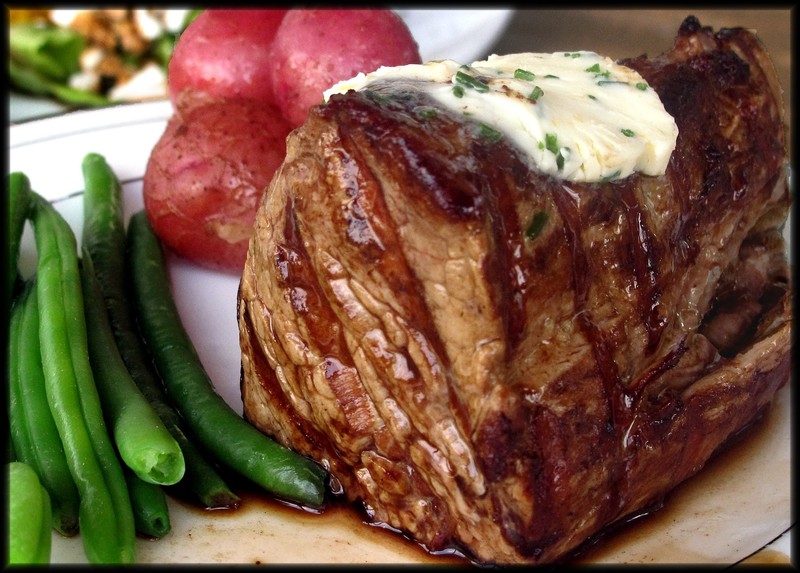Next week brings the annual Fourth of July celebrations - parties, parades, games and fireworks. Many of our neighbors are scrambling to stock pantries and prepare guest rooms for the arrival of friends and family. This year we’re breaking with tradition: instead of hosting a houseful of company, we’ll be on our own. As a special treat, we’ll forgo the standard barbecue fare of burgers or ribs and splurge on steak.
And not just any steak, but the darling of them all, filet mignon. With a name that translates from the French to dainty or darling fillet, this cut of beef comes from the slender end of the tenderloin. Whole tenderloins are long, cylindrical pieces sliced from along each side of the cattle’s spine. These are either sold intact or butchered into rounds about three inches wide and one and a half inches thick. The more perfectly round pieces from the center are called tournedos, and those from the narrow end are the filet mignon.
If you order filet mignon at a restaurant, you’ll typically be served tournedos, since their more regular shape is easier to cook than the almost cone-shaped filet mignon. These are the tenderest cuts of beef because they come from a muscle that does not bear any of the animal’s weight and has almost no connective tissue. Of course, along with their extreme tenderness comes an extreme cost; these will usually be the highest-priced steaks at the butcher counter.
Now that we’ve purchased such lovely steaks, how do we cook them to perfection? To start, the lack of marbling gives the meat a tendency to dry out when either grilled or pan-fried. In addition, the fat in beef is the source of its rich flavor. As a result, most recipes for filet mignon incorporate added fat or butter-based sauces. The goal is to carefully manage your timing to ensure the meat is served rare, rather than well done.
Traditionally, the room-temperature meat is quickly seared on both sides over intense heat, then transferred to the oven to finish cooking at a lower temperature. We followed this process, using a ribbed grill pan on the stovetop followed by a few minutes in a 325-degree oven. To keep the meat from sticking to the pan, we coated the inside with nonstick cooking spray. If you’re grilling on a gas barbecue, you can rub the meat itself with a bit of canola oil.
One thing you may not want to do when cooking a filet is to marinate it beforehand; acidity in most marinade mixtures can turn the meat to mush. A better approach is to wrap a slice of bacon around the outside of the meat and secure it with a toothpick; this will impart flavor and keep the meat moist while it’s cooking. Another risk is the unpredictability of a gas grill (despite our five-year relationship, I still don’t trust mine). Unless you’re certain of its temperature and consistency, you may be happier with stovetop results.
For the sauce, we skipped the tarragon-scented Béarnaise favored by many restaurant chefs and opted for a lemon-chive compound butter. As you can see in the photo, a thin slice of flavored butter melts into the hot steak, adding just a touch of extra moistness to the fork-tender beef. Tiny new potatoes were tossed with another bit of the butter, and steamed haricots verts rounded out the meal. Now we’re ready to go watch the Lewes Doo Dah parade and collect some candy for dessert.
Skillet Filet Mignon
filet mignon (one per person)
salt and pepper, to taste
Remove meat from the refrigerator and allow to reach room temperature, about 20 minutes. Preheat oven to 325 F. Coat the inside of an ovenproof skillet with nonstick cooking spray. Heat the skillet over high until shimmering but not smoking. Pat dry the outside of the steaks and place them in the pan. Cook for 3 minutes. Turn over steaks tinue cooking another 3 minutes. Remove steak from the stove and place in the preheated oven for 5 minutes. Season to taste with salt and pepper, and garnish with compound butter.
Lemon Chive Butter
1/2 C unsalted butter
2 T snipped chives
1 T lemon juice
1 t lemon zest
1/4 t salt
Combine ingredients in a small bowl, mixing thoroughly to combine. Form into a ball and place on a piece of plastic wrap or waxed paper.
Roll the butter into a log and twist closed the ends of the wrap. Place in the refrigerator to chill until firm. To serve, remove from wrap and slice 1/4 inch rounds to season grilled chicken, steak, burgers, fish or vegetables.
Herb Butter
1/2 C unsalted butter
1/4 C chopped fresh herbs*
1 grated garlic clove (optional)
1/4 t salt
Combine ingredients in a small bowl, mixing thoroughly to combine. Form into a ball and place on a piece of plastic wrap or waxed paper. Roll the butter into a log and twist the ends of the wrap to close. Place in the refrigerator to chill until firm. To serve, remove from wrap and slice 1/4-inch rounds to season grilled chicken, steak, burgers, fish or vegetables.
*Note: select from basil, dill, parsley, rosemary, sage or tarragon, making sure to use only the tender leaves, none of the woody stems.
Sourdough questions
Last week’s column on sourdough generated a few questions:
• Why does the raisin bread recipe call for yeast as well as sourdough starter? To help the dough rise more quickly, especially since it’s studded with raisins that are heavier than dough alone.
• Can I make my own starter? Yes, there are several excellent websites that describe the process; however, it may take as long as two weeks, which is why a commercial starter is easier.
• Where can I buy liquid (not powdered) starter? Try one of the many online sources (e.g., www.kingarthurflour.com) or ask a friend to share some of theirs with you.
























































